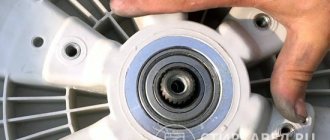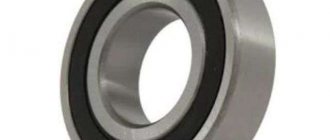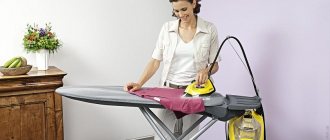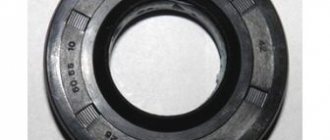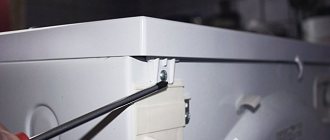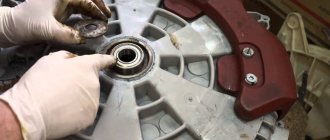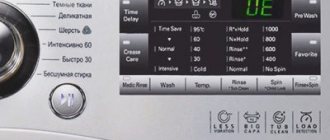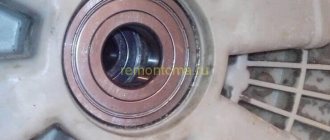What is washed. There is no way for an automatic car without a drain pump - many people know and understand. But not everyone can correctly say what its role is in washing technology. And its role is enormous - as it turns out, you can’t do without a pump when draining water and even launching any of the programs. And all because the drain pump is involved in the washing, rinsing, spinning and drying process.
Although all the main programs of an automatic machine where the pump is involved are listed above, the most important role of the pump is to drain water from the washing equipment.
What is an SMA drain pump?
A pump is, as a rule, a low-power, asynchronous motor with a magnetic rotor (rotation speed up to 3 thousand / min). Drain pumps differ from each other in the type of “snail” or the filter connected to it (it serves to retain various “garbage”). The motors of these pumps are endowed with a power of up to 130 W, and the rotor “can” rotate only in the prescribed order.
But there are pump motors with a power of 30 W, which are not equipped with the function of a set rotational direction and are quite often used in many washing machines. The rotor in them is similar to a cylindrical magnet, and the impeller is fixed on the rotor axis and is a unique mechanism (it has a considerable rotation angle relative to the axis and is equal to 180 degrees). When the SMA drain pump starts its work, the rotor starts up first, and only then the impeller is connected to the process.
You also need to know that the motor core has 2 windings. They are connected to each other, and their resistance is about 200 Ohms. All low-power drain pumps have one feature: the external “volute” fitting is necessarily located in the middle of the housing. This fitting has a rubber check valve.
A valve is a device that prevents water from flowing into the SMA container from the drain hose. And it works like this: it opens under the pressure of the water flow of a working pump and closes when the drain mechanism stops working.
As for other pump devices that have a given specific direction, rubber cuffs are used to seal (so that water does not penetrate into the bearing). In this case, the rotor shaft passes through a collar bushing (central), which has corrugations along the edges and a compression ring made of a spring ring. But first, install the cuff on the bushing - it is generously lubricated with special lubricant. This procedure significantly increases the service life of the entire part. We must take into account the fact that if the pump fails, it is better to replace it with a new one. And all because experts assure that the drainage device cannot be repaired. And then ATTENTION! If you are not a specialist in washing equipment, then you should not replace it yourself. To do this, you just need to call a qualified technician by calling the repair service. By the way, they will help you not only with the problem of SMA, but also with all household appliances.
Why can an “accident” happen with the pump of an automatic washing machine?
The service life of a drain pump or pump is about 11 years. But this is provided that the owners of the equipment are not careless and do not “stuff” laundry into their washing “assistant” every time they wash it without checking the pockets in it for the presence of hard and metal objects. Because it is precisely what is in the pockets that becomes a frequent cause of breakdown of the drainage device of any wash. machines: hairpins, coins, pins and so on.
Also very dangerous for pumps are toothpicks, loose buttons, beads and rhinestones. All these items not only lead to severe wear on the parts of the SMA drain pump, but can also be responsible for its complete breakdown.
Another fairly common cause of washing pump failure. automatic machines can be considered coarse dirt, as well as scale. A seal made of plastic or rubber can be severely scratched by sand or particles of hardened scale. And these “foreign” substances often settle on the impeller, axle and in the “snail”, which after a while will cause the specified spare parts of the pump to come out.
In order to avoid the negative factor first described, it is necessary to use filters and additives that make the water softer on the inlet filler pipe. But to prevent the second incident from happening, you will need to carefully remove pieces of dried dirt from your clothes before washing. After finishing washing, try to drain all the used water from the tank of the automatic machine completely. In addition, it is not recommended to wash things in this technique that cause pump clogging, for example, a pet rug. The long hair of cats and dogs is especially dangerous for the drain pump (or rather, its parts). Therefore, if you still want to wash the rug, then do not forget to clean it well first.
What is an oil seal?
The tightness provided by the sealing element is achieved due to the materials from which it is made. This is usually rubber, silicone rubber, fluorine rubber, or something else. There is a metal insert inside it, thanks to which the part retains its shape. Even though the insert is made of metal, it is extremely fragile, so you need to be especially careful when handling it.
During operation of the device, the machine shaft constantly interacts with the inside of the oil seal.
Lack of lubrication on the sealing part leads to increased friction, which results in rapid wear. Obviously, the tightness in this case will be compromised, and the safety of the bearings will be jeopardized. Grease for washing machine seals will help avoid the problem.
Where can I get lubricant?
It is best purchased in specialized stores that sell equipment for repairing household appliances. Often, washing machine manufacturers also produce lubricants, claiming that this particular lubricant is suitable for a particular brand of machine. In cases where the cost of such a lubricant does not allow you to purchase it, you can buy an ordinary one, it will be no worse.
What you definitely shouldn't do is save money. Some owners of washing machines lubricate the sealing part with ordinary vegetable oil, others use grease for this purpose. In this case, not only will the machine not work better, but with a high probability the thrifty owner will have to repair it within a few months.
Selection Criteria
In order for the oil seal to work for a long time and properly, it is necessary to choose the right lubricant.
The following criteria must be taken into account:
- Water resistance .
If it is not waterproof, a solution of water and washing powder will wash it out of the sealing part in no time. - Non-aggressiveness .
If the lubricant is too caustic due to certain chemicals in the composition, it can damage both the sealing element itself and the metal axle shaft. - Viscosity _
The liquid composition will simply flow out and be washed away with water; it will not be of much use. - High temperature resistance. During operation, the sealing part heats up, so the lubricant must withstand temperatures of 180-200˚C well.
Operating rules
In order to operate the washing machine for as long as possible without repairing (replacing) the drain pump, you must follow certain rules:
- When connecting yourself, carefully ensure that the end of the drain hose is located at least 50 cm from the floor.
- Heavily soiled clothes (especially those with traces of soil) are soaked for some time in a warm soapy solution before loading into the drum.
- Before each wash, carefully inspect and clean the pockets of small debris and small objects.
- To prevent scale build-up on the inner walls of the drain pipes, add a special agent that softens hard tap water along with the washing powder.
Compliance with basic operating rules guarantees up to ten years of uninterrupted operation of the drain pump.
Instructions
After the lubricant is selected and purchased, it must be used for its intended purpose. Lubrication is often carried out after.
First you need to carefully remove the cover, and then remove the walls - front and back. Inside the washing machine there is a tank that needs to be disassembled into two parts. After this, it will be possible to get to the bearing assembly and the bushing with the oil seal.
Automatic washing machines are a fairly reliable type of equipment today, and if they break down, they are usually fixed. One of the most difficult and expensive breakdowns to repair is bearing wear in a washing machine. If the bearing is worn out, it needs to be replaced. As a rule, such complex repairs are trusted to professionals, because in order to carry out it yourself you need to have the necessary skills and tools.
If you decide to change the bearing in the washing machine yourself, you will be faced with a bearing seal in the washing machine that requires the necessary lubrication. Here we will deal with this issue and tell you how to lubricate the oil seal in a washing machine.
What is a seal in a washing machine?
An oil seal is a rubber sealing ring that is necessary to seal the gaps between static and moving parts. In our case, the oil seal is a rubber ring that prevents water from flowing out from the washing machine tank through the gaps between the tank and the shaft.
As you can see from the photo above, the oil seal is inserted onto the bearings, and inside has a hole for the shaft. As you already understood, when rotating, the shaft constantly rubs against the walls of the oil seal, thereby wearing it out. Therefore, the seal must be well lubricated to last longer.
Causes of pump failure
- The pump broke down due to a malfunction of the engine, as a result of which there is no voltage to the pump.
- The seal (rubber or plastic) is damaged by scale and dirt that settles on the impeller.
- Incorrect connection of the pump or failure of the water level sensor causes the pump to constantly operate.
- The pump will not be able to drain water due to a clogged filter.
- Small foreign objects destroy the impeller. It's easy to diagnose. When the pump starts, the machine makes a hooting sound.
What happens if you don’t lubricate the oil seal in the washing machine?
If you changed the bearing and forgot to lubricate the oil seal, which is unacceptable, then you may experience the following problems: the oil seal will wear out very quickly, it will not last long, working “dry”, after which it will begin to leak water. Water will enter the bearings, which will also begin to rust very quickly, and their frictional force will increase. You will need to change them again along with the seal. Therefore, you definitely need to take care of lubricant for washing machine seals
and buy it in advance, before starting repairs.
Possible difficulties
When repairing a Bosch washing machine, you may encounter various difficulties:
| Problem | Ways to solve the problem |
| The screwdrivers provided do not fit the mounting screws. | You should take care in advance of a large set of screwdrivers and heads |
| The tank cannot be removed from the housing after disconnecting | You should check whether all fasteners have been disconnected, and whether the counterweights, which significantly weigh down the structure, have been removed. |
| After assembly and during the first start, a puddle appeared under the washer | To determine the location of the leak, the washing machine will have to be disassembled and diagnosed |
| Screws missing during installation | Screws lost due to carelessness can be replaced with similar ones. |
| Bearing cannot be removed | WD-40 can help remove stuck parts. |
| Some screws won't come out | |
| The new bearing does not fit the seat | It is likely that the bearing you purchased does not fit your existing washing machine model. |
What are the lubricant requirements for oil seals?
Of course, there will be those who will say that the oil seals can even be lubricated with sunflower oil, but for them we have serious arguments why this should not be done.
- Lubricant for oil seals must be moisture resistant
. This is necessary so that it does not wash out with water over time. - The lubricant should not be aggressive and “corrode” or soften the rubber
. If you lubricate the oil seal with a lubricant that is not intended for this purpose, it can shorten its service life. - Heat resistance
- since when the washing machine is operating, there is constant friction between the shaft and the oil seal, as well as the operation of the bearings, and they heat up. Also, when washing in hot water, the lubricant is affected by temperature, so the lubricant should not lose its properties when the temperature changes. - The consistency of the lubricant should be thick
so that it does not leak out during long-term operation.
As you can see, oil seal lubricant must be taken seriously, since the “wrong” lubricant can ruin all your work on replacing bearings and hasten a new similar repair.
Required Tools
Repairing the pump is simple, as it does not require many tools or special devices. Most often, three things are enough for dismantling and repair:
- Phillips screwdriver;
- sharp knife or chisel;
- electric voltmeter.
Pliers or pliers are useful as auxiliary tools to remove the clamps from the hoses.
Prepare a dry rag and bucket in advance . There will likely be a small amount of water in the pump that will spill onto the floor.
Choosing a lubricant for the washing machine oil seal
You can buy special lubricant in specialized stores that sell spare parts for washing machines. If you tell the seller why you need lubricant, then he will probably give you a suitable tube without any questions. The only problem is that such a lubricant will be expensive, since it is believed that it is specially designed for this purpose.
Of course, you can try to save money and find cheaper analogues. Silicone grease is considered a good lubricant for oil seals.
, it meets all the requirements, and most importantly, it has good moisture resistance.
When purchasing silicone grease, pay attention that it is moisture- and heat-resistant, and also thick. Usually these parameters are indicated on the tubes: moisture resistant, operating temperature limits.
One of the excellent silicone lubricants for oil seals is LIQUI MOLY “Silicon-Fett”
, which meets all requirements. Of course, it is not cheap either, but its quality is high. You can safely lubricate the oil seal in the washing machine with it. Its operating temperature ranges from -40°C to +200°C.
You should not skimp on lubrication: you do not need to lubricate the oil seal with lubricants such as Litol, Tsiatim, Azmol and others. When using these lubricants, your washing machine will start squeaking very quickly and you will have to change the bearings again. Believe me, it will be much more expensive to change the bearings again than to spend money now on good lubrication.
If the impeller turns?
In such a situation, the automatic washing machine begins to drain the waste liquid from the tank, then the pressure becomes very small, and as a result, the water either takes a very long time to drain or does not drain completely and remains in the tank. At first glance, the drain pump may seem to be fully operational, the pump impeller “sits” tightly in place, so what’s the problem?
Most likely the impeller is turning. During normal operation, if you rotate it with your fingers, the impeller should rotate in jerks, this indicates that the pump magnet is overcoming resistance. When the impeller rotates freely and spins on the axis without stopping, it means that the device is not working properly. Such scrolling can be caused by foreign objects that periodically enter the drain system or by a banal factory defect.
There is only one solution to the problem - completely replacing the drain pump of the washing machine. You can purchase it at specialized retail outlets or online stores using the machine model number.
How to lubricate the oil seal of a washing machine
You have changed the bearings and now you need to insert the oil seal, but before that you need to lubricate it. To do this, take the lubricant and apply a thin layer of it along the outer contour of the oil seal.
, spreading evenly.
After this, insert the oil seal into the niche in the tank.
Next, lubricate the oil seal along the internal contour
.
All! This completes the oil seal lubrication. Now you can continue assembling the washing machine.
Does your washing machine make a lot of noise when operating? Do you hear extraneous sounds and creaks? Such signs may indicate bearing wear. In most cases they need replacement, but even when installing new parts, they are thoroughly lubricated.
What kind of lubricant is used in bearings and what properties it has, you will learn in this article.
Before you get started, you need to find out what kind of lubricant to lubricate the bearings with. There are only a few types of lubricants that meet these requirements:
- They are moisture resistant. Since the CM shaft parts are constantly in contact with water, you need a water-repellent bearing lubricant. If water washes away the substance that makes the bearing slide without wear, it will soon wear off.
- They have heat-resistant properties. Hot water in the tank and heating of the shaft during rotation can deprive a cheap lubricant of its properties. Then water will get on the parts and corrosion will begin.
- They should not have an aggressive effect on the rubber. Otherwise, the seal may become stiff, which will lead to water leakage.
- Bearing grease should be thick. Otherwise, it will simply leak out during operation.
Many users are interested in whether it is possible to lubricate bearings with Litol and other automotive lubricants. It is not advisable to use such means. They provide poor protection, so soon you will have to repair the washer again.
Which remedy should you choose?
AMPLIFON is offered by Italian manufacturers MERLONI. This is a moisture-resistant lubricant that is not washed out by water.
Anderol is known for its convenient dosage of 100 grams in jars or syringes for two uses. The product is produced by the manufacturers of Indesit washing machines.
STABURAGS NBU 12 is a water-resistant bearing lubricant that will provide a high level of wear protection. Heat-resistant and resistant to aggressive environments (cleaning solutions).
LIQUI MOLY "Silicon-Fett". Silicone grease for washing machine bearings. It has a thick texture and heat resistance (withstands from -40°C to +200°C). Adheses well, providing a high lubricating effect.
Huskey Lube-O-Seal PTFE Grease. Sticky, homogeneous texture, cannot be washed off even with a water jet. Heat-resistant, withstands from -18°C to +117°C. High corrosion protection.
What is better to lubricate
Some people think that the oil seal is processed first, while the support bearing does not need to be lubricated. This is only true if you purchased the original part.
Note! When processing the oil seal and bearing, never mix lubricants, as they may not be compatible with each other.
Stages of work
You need to start by disassembling the washing machine and removing the bearings. For any brand and model, the disassembly principle is almost the same.
Remove the top cover by removing the screws from the back that hold it in place. Then push it forward and out of the way.
Remove all the screws around the perimeter of the back panel that hold it in place. Now move to the front of the case.
- Pull out the detergent tray by pressing the lock in the center.
- Unscrew the bolts that are located behind the tray, as well as on the opposite side of the control panel.
- Release the plastic latches and remove the control panel. If you decide to unfasten all connections, take photographs of their locations in advance.
- Open the hatch door. Bend the cuff and remove the clamp. Place the sealing rubber inside the tank.
- Remove the two screws holding the hatch lock. Unfasten the wiring from the lock.
- Unscrew all screws holding the front panel.
Remove the upper counterweight by unscrewing the mounting bolts.
Now you need to get the powder receptacle. Using pliers, loosen the clamp that secures the pipe to the cuvette. Disconnect the pipe. The filler valve hoses are also attached to the powder receiver. You can disconnect them, but it is easier to remove them together with the valve. For this:
- Unscrew the bolt on the back wall that holds the valve.
- Disconnect the wiring from the valve and remove it from the housing along with the cuvette.
Also unfasten the pressure switch hose that is attached to the tank.
Remove the front tank counterweights by unscrewing the bolts.
If the heating element of your washing machine is located in front under the tank, disconnect its connectors. Then, using wire cutters, remove the wiring clamps and remove it from the tank. Unscrew the screw of the drain pipe clamp. Remove it from the tank.
Be careful, water may spill out of the spigot.
Disassemble from behind
Remove the drive belt by pulling it to the side and turning the pulley.
If the heating element of the car is located at the rear, unfasten its wiring, as well as the engine connectors. Now unscrew the motor bolts and pull it out of the housing.
Unclench the plastic clip and unfasten the pressure chamber that is attached to the tank. Unscrew the shock absorber bolts. Lift the tank and remove it from the hooks, pulling it out of the housing.
Place the tank on a flat surface. Remove the sealing rubber of the hatch by removing the inner clamp. Turn the tank over and remove the pulley by unscrewing the central bolt. Pre-secure it with a wooden plank.
Separate the two parts of the tank by unscrewing the screws around the perimeter. Take out the drum. Now you get to the bearings. Now you will learn how to properly lubricate a bearing in a washing machine.
Finish work
Remove the bearings from the tank. To do this, pry the oil seal with a screwdriver and pull it out. Place a chisel on the outer race of the bearing and, tapping with a hammer, knock it out of the tank. Do the same with the second element.
If you have decided which bearing lubricant is best to choose, then after cleaning you need to remove the protective cover of the part. The product is placed inside.
But how is a non-separable, sealed bearing lubricated?
- Take WD-40, spray the parts with it and wipe well with a rag.
- After cleaning, you need to open the lid, but it does not work.
- Fill the inner ring of the part with a plastic bag.
- Take a tube of lubricant and cut the neck so that it is equal to the diameter of the inner ring of the bearing.
- Place the tube on the inner race and squeeze out the lubricant until it starts to come out from the opposite side.
- Then start rolling the bag around inside to distribute the lubricant. If you were wondering whether sealed bearings need to be lubricated, now you know what is necessary and possible.
- Remove any excess. Reinstall the part.
Is it difficult to find a pump?
The location of the drain pump is standard in almost all LG models, regardless of whether the machine has a direct drive or a belt drive. Moreover, getting to the location of the malfunction will not be difficult - you will not have to completely disassemble the case. There is also no need to even unscrew the back wall, top cover, tray or front panel. Finding the pump is much easier, since it only requires a series of simple steps.
- Disconnect equipment from electricity.
- Drain waste water from the drum using the emergency drain.
- Shut off the water supply and disconnect from the sewer.
- Tilt the body back, placing old rags under the machine.
All. We look under the bottom and get free access to the entire drain system. There is another way - move the machine to the center of the room and place it on its left side.
How to lubricate the oil seal
Now about how to restore the oil seal with your own hands. Of course, a worn oil seal cannot be repaired. Remember a simple rule: if you decide to replace one element, you need to change the entire set if you want to perform high-quality repairs.
Automatic washing machines are indispensable and the main assistants of our housewives. They save a lot of our time, which we can additionally spend on work, our hobbies or family.
Automated units save energy, water and washing powders with great precision, thereby justifying their considerable cost. When washing in a machine, many times less water is used than in labor-intensive manual processes, and accordingly, less powder is consumed to achieve the washing solution of the required concentration.
But like any equipment, washing machines require periodic maintenance and repair. Despite the direct contact of many parts of these products with water, many components of washing machines are protected from moisture getting on them.
Many components are protected by special sealing gaskets, cuffs and oil seals, and if these safety elements are damaged or worn out, other parts are subject to rapid deterioration. To avoid additional costs for repairing your assistant and to correctly carry out preventive maintenance and maintenance of the product.
- At the first sign of a malfunction, you need to take measures to eliminate it. In case of leaks, it is necessary to eliminate the tightness of the connections of the prefabricated units, and if noise occurs, pay attention to the bearing unit.
- Noise at high speeds or the appearance of grease on things indicates that the bearings need to be changed in the washing machine. The ring-shaped rubber band serves the function of insulating the bearing assembly from possible moisture ingress due to bearing corrosion and failure.
- A common reason for rapid wear of the oil seal is frequent washing at high temperatures. The rubber from which the part is made requires such heating, but due to frequent heat treatments it loses its elasticity.
- When replacing bearings, the oil seal must also be replaced with a new one, which in turn is lubricated with a special lubricant. The composition of washing machine lubricant for oil seals should make it water-repellent and not change its properties at high temperatures. In this article we will look at how to properly lubricate a washing machine part and with what.
The part has the shape of a ring filled with rubber, the inner diameter of which seals the shaft rotating inside. When subjected to friction, it is subject to high heat and must be lubricated to avoid rapid wear and loss of seal.
In the absence of lubrication inside, the oil seal quickly wears out and leads to malfunctions and breakdowns of other parts of the mechanism, such as the bearing assembly. Replacing the oil seal of a washing machine must be accompanied by lubrication, otherwise the repair performed will have to be repeated in the near future.
Grease for washing machines can have a variety of names, colors and packaging, but must meet certain requirements:
- Be water repellent. Many people think that all lubricants, due to their greasy appearance, have this quality. This is far from true. Before use, be sure to make sure that your lubricant has a water-repellent effect. This will significantly increase its service life;
- Withstand high temperatures without changing its properties. The washing machine involves heating water to boiling and the rubber part is directly subjected to this heat treatment, so the lubricant should not spread or harden;
- Neutrality to the oil seal rubber. The lubricant should not be aggressive to the rubber composition of the part; it should not affect its elasticity and resilience.
What lubricant to use for the washing machine oil seal
Nowadays there is a large selection of lubricants on the market and any table of spare parts for washing machines also includes its availability. There are specially designed options, but the point is that you won’t need a whole package to carry out the repair yourself, and it will cost a lot.
Packages usually contain 50-100 grams of material, and with lubrication you will need 1-2 grams.
Here are some of them
:
- Huskey Lube-o-Sela lubricant (100 g - packaging);
- Hydra lubricant (100 g).
If there is no original lubricant, the washing machine oil seal can be lubricated with others, the main thing is that they meet the requirements of their future operation.
At home, you can lubricate the oil seal of a washing machine with the following lubricants:
:
- Litol (or Litol-24). It has chemical and mechanical stability in the temperature range from 40 to +120 degrees Celsius.
- Cyatim 221. Performs excellently in high friction units and does not change its basic properties at temperatures up to +150 degrees.
Also many automotive and other solid lubricants, of which there are a huge number today, including silicone analogues of washing machine oil seals.
Electrical repair
The electrical part of the pump includes the following components:
- inductor;
- starting capacitor;
- connecting wires;
- control terminal.
If the stator winding breaks down, the pump becomes unrepairable; all other components can be repaired or replaced. To analyze the condition of electrical parts, you will need an ohmmeter.
Photo of the circulation pump Wilo MTSL 15/5 HE – 2.
Main symptoms of malfunction
If the boiler display shows an error code corresponding to a water circulation problem, and it is not reset, the problem may be hidden in the electronic part of the device.
Circulation pump with cover removed.
To identify the problem you must:
- Turn off the heating mode in the boiler, and after stopping all components, turn off the power (soft stop).
- Open the front panel of the case.
- If the pump is covered with a large layer of dust, clean its surface.
- Using the information in the diagram, remove the control terminals and remove the terminal with the capacitor.
- Visually examine the condition of the pump contacts and terminals; they should be free of oxides, burnouts and mechanical damage.
- Using a tester in diode testing mode, determine the integrity of the connecting wires that go from the control board to the pump.
- Use an ohmmeter to determine the resistance of the inductors. On a working device, the instrument readings on the contacts will correspond to the following values:
- No. 1, 4 – 150 – 160 Ohm;
- No. 1, 6 – 290 – 300 Ohm;
- No. 2, 3 – 0 (contacts connected together);
- No. 3, 5 – 220 -230 Ohm;
- No. 4, 6 – 150 – 160 Ohm.
- The device will be considered faulty if the ohmmeter reading on any of the above pair of marks is 1 (winding wire break) or 0 (short circuit, except for contacts 2,3).
- Check the condition of the starting capacitor. To do this, switch the tester regulator to the 20 microfarad capacity test mode. Connect the probes of the device to the terminals of the capacitor and determine its capacitance. It should match the nominal ± 10%. Loss of capacity leads to a decrease in pump performance; it will emit an uncharacteristic hum.
Electrical diagram of the pump Wilo MTSL 15/5 HE – 2.
Measuring the resistance of the circulation pump windings.
How to properly replace the seal in a washing machine
The process of processing the bearings and oil seal does not take as much time as the process of disassembling the washing unit itself will take. In order to get to the oil seal, you will need to disassemble all or most of the machine, remove and disassemble the tank, and in some cases, cut it.
But at the first signs of oil seal wear, it is better not to delay replacing it. Moreover, this will still have to be done soon, but if you delay it, the repairs will become more difficult and require a much larger budget. Many washing machines do not require complete disassembly; you just need to remove the rear inspection window, dismantle the hub and carry out the process of replacing and lubricating the parts.
For example, a large number of vertical models are equipped with removable hubs on the outside of the tank. Replacing them does not take much time, but they cost quite a lot. And in vertical machines there are two of them, on different sides of the product, which usually has two covers for removing the necessary components, which makes your work easier.
It is precisely in this case that it is necessary to lubricate the necessary parts in a timely manner in order to increase their service life. Installing the washing machine oil seal when replacing bearings is a mandatory procedure that requires special attention. After removing the old rubber and worn-out bearings, it is necessary to thoroughly clean and lubricate the hub before installing new parts.
After installing the bearings in the washer, you need to correctly place the part with a spring inside the hub. A waterproof lubricant for washing machine seals should be placed inside it. Oil seal lubricant can be original or similar. After this, carefully insert the washing machine drum shaft into the hub with new parts, first clean the bronze bushing on the shaft.
It is recommended to carry out the first test wash with detergents at medium temperature in order to remove any grease that may have gotten inside the tank. Maintenance should be carried out periodically to remove all kinds of accumulated dirt and scale that affect the elasticity of rubber parts.
You should also pay attention to the quality of the powders used when washing and do not abuse high temperatures, especially since this does not have a very favorable effect on the quality and durability of the items being washed.
The oil seal is perhaps the only part that is in direct contact with the engine shaft, and therefore, lubricant for oil seals is absolutely vital. Otherwise, during the friction process, this part will very quickly fail.
The price of the oil seal is mere pennies, but if it is destroyed, very soon a sad fate will befall the bearing, the price of which in the store is quite high.
The oil seal is a rubber ring that serves to seal possible leaks between static and moving parts of rotating mechanisms.
Replacing a bearing is an operation that will happen one way or another if your SMA is in use for long enough. In principle, this procedure is not complicated; it can be said to be quite routine. But there is one significant “but”. If you replace the bearing, but ignore such a step as lubrication, then all the work will go down the drain and, alas, you will have to pay twice in the store.
A seal running “dry” will very soon wear out and begin to leak water. This, in turn, will quickly destroy the bearing. Thus, there is no doubt - lubricating washing machines is a necessary operation, and neglecting it, as they say, is more expensive for yourself.
So, we agree that lubricant for oil seals is necessary. Now, to solve the problem formulated above, let’s try to answer the question of which lubricant for washing machine oil seals is best suited.
Installing the impeller in place
If you cannot quickly purchase a new drain pump, you can use a simpler, but at the same time not very reliable option - try to put the impeller in place using waterproof glue or sealant. If you fasten a plastic part in this way, you can correct the situation, but just for a few wash cycles. It will not be possible to operate the machine for a long time, since the impeller will soon fall off and the waste liquid drainage system will fail again.
So, if the impeller is broken, and there is no time to fully replace the pump, you can do the following:
Please note that this method will not eliminate the problem, but will only help to temporarily cope with it.
Try to replace the faulty drain pump with a new one as soon as possible. This way you can forget about the problem of draining water for many years.
Analysis of materials
To solve the question of how to lubricate a bearing in a washing machine, we need to understand what we want to get.
- moisture resistance. A necessary requirement that needs no comment is that waterproof treatment is a priority;
- the lubricant must be neutral in relation to rubber, otherwise the oil seal will quickly fail;
- The oil seal is constantly exposed to friction, and therefore to high temperatures. Therefore, one of the requirements for the oil seal must be its heat resistance;
- In order for the product not to flow out, the consistency should be viscous.
Causes of pump failure
- The pump broke down due to a malfunction of the engine, as a result of which there is no voltage to the pump.
- The seal (rubber or plastic) is damaged by scale and dirt that settles on the impeller.
- Incorrect connection of the pump or failure of the water level sensor causes the pump to constantly operate.
- The pump will not be able to drain water due to a clogged filter.
- Small foreign objects destroy the impeller. It's easy to diagnose. When the pump starts, the machine makes a hooting sound.
Lubricant selection
Immediately remove the following message: you cannot skimp on processing lubricants for oil seals. Go to the store and choose. Good material in the store is expensive and you have to agree with this. Another thing is how to choose a reliable and durable one from the abundance of expensive products.
Let's try to conduct a short review of the materials. When visiting a store, you need to remember that some products can be replaced, and some can be completely removed from the agenda. The top five best impregnations for SMA oil seals include the class of silicone lubricants.
Advantages of silicone lubricants, what to replace?
Wherever silicone-based materials are used! In dentistry, plumbing, printing, etc. Since the temperature range of silicone materials ranges from -45 to +300 °C, they are also used in precision electronics. Silicone material forms on the surface being treated a saturated layer of polymer material consisting of uniform silicone molecules. He is:
- slippery and water-repellent;
- adhesive (ability to adhere to any surface) to metal, rubber, plastic;
- effectively resist friction.
Experts recommend using specialized products for washing machines, without resorting to proven products such as Tsiatim, Litol or Azmol. For consultation, contact any specialized store. The effect of using these funds, of course, will be, but, alas, not long-term. Very soon the bearings, under the influence of an aggressive environment, will begin to “creak” and “crumble.”
Which lubricants are better?
Litol-24. Production: mineral oils are thickened with a mixture of lithium technical soaps with the addition of antioxidant additives. Pros: waterproof, high chemical and thermal resistance. If you remove the temperature range, it will be from -45 to +139 °C. Adequate replacement for SHELL.
CIATIM-221. The advantages include resistance to high temperatures and stability during prolonged friction, which has a positive effect on the operation of the bearing seal; waterproof. The downside is weak hygroscopicity, i.e. With constant exposure to a humid environment, the material becomes unusable, although this process can take years. A good replacement is the SHELL series.
LITIN 2. In this case, we are dealing with a highly specialized product intended for use in extreme conditions on vehicle components, which means it has a multiple margin of safety and “survivability.” This product has proven itself to be a worthy replacement for products from a brand such as SHELL, which in itself is a high indicator.
CIATIM-201. This product has found its application in friction points of aircraft equipment, where it is necessary to relieve high thermal stress. The lubricant remains operational for more than 600 hours of flight time.
CV joint-4M. Used in extreme motorsports to lubricate ball suspensions and joints of racing cars. It has unique antioxidant and extreme pressure additives and is extremely waterproof.
It should be understood that any material can be removed and replaced with an analogue. Thus, when choosing a lubricant in a store, you should first of all focus on the price according to the principle “good things cannot be cheap,” and the use of the product is designed for at least years to come.
How to lubricate?
Now let's look at the algorithm step by step on how to lubricate a bearing in a washing machine.
In this article, we consider the process of disassembling the SMA purely briefly. Our task is to apply the necessary products to the oil seal. Our steps: unscrew the 4 bolts and remove the back cover, then remove the belt. Remove the bearing block cover and unscrew the main bolt. Remove the bearing. Unscrew and remove the product holders, then release the seal.
Questions such as how to remove this or that block and then replace the part are the topic of other articles. So, remove everything that needs to be removed, unscrew and disconnect the necessary parts. Before us are a bearing and an oil seal. Then the oil seal must be lubricated. Unscrew and remove the cap, disconnect the feeding device - the product is ready for use.
As a rule, the product is packaged in a tube, which simplifies the process of use: unscrew and remove the cap and it is ready for use. So, unscrew and remove the cap and then apply the product. First, you need to apply the product to the outer contour of the oil seal, trying to do it evenly, without leaving dry areas. To do this, remove the cover, unscrew the bearing from the seal, then remove the cover and place the seal in the niche provided for it, then remove everything else.

